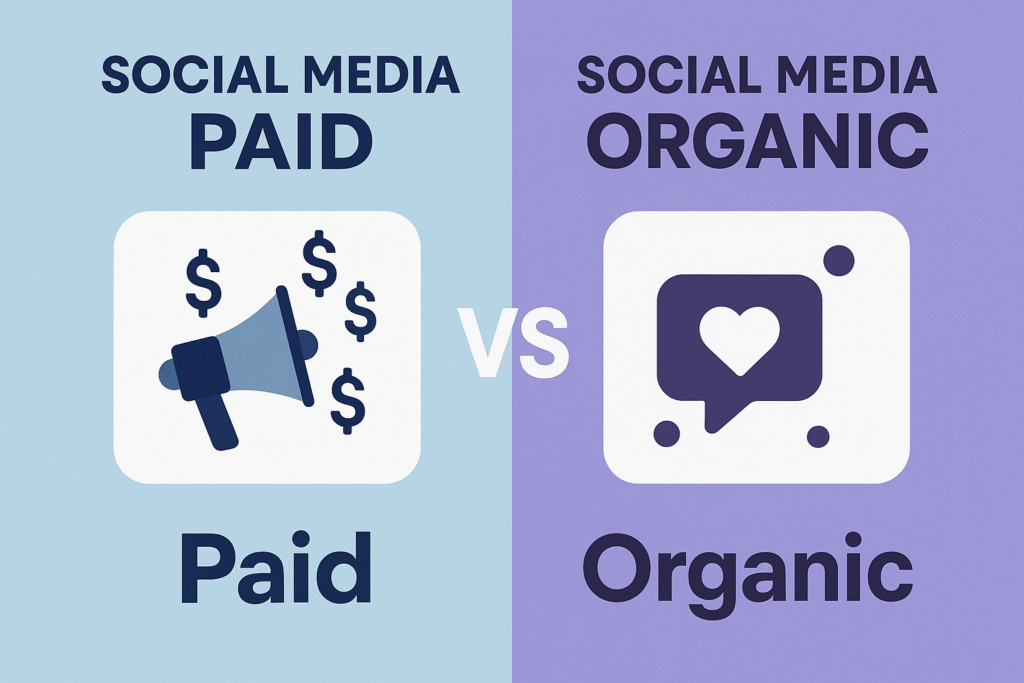
Introduction:
In the fast-paced world of social media marketing, one question continues to dominate boardrooms and marketing meetings: Should we invest in paid media or stick to organic growth? The truth is, both strategies offer unique benefits, and understanding how to balance them can be a game-changer for your brand.
Whether you’re a startup trying to build an online presence or an established business seeking more conversions, the battle between paid vs. organic social media is one you need to understand deeply.
What is Organic Social Media?
Organic social media refers to the free content (posts, stories, videos, etc.) that brands share with their followers across platforms like Instagram, Facebook, LinkedIn, and Twitter. The goal is to build relationships, establish trust, and nurture long-term engagement without spending money on promotions.
Examples of organic efforts:
- Regular posting (behind-the-scenes, educational content, memes)
- Engaging with followers via comments and messages
- Hosting giveaways or collaborations
- Sharing user-generated content (UGC)
Pros of Organic Social Media:
Authenticity: Organic content tends to come off more genuine, which helps build brand trust.
Community Building: You’re growing a loyal audience over time who supports your brand.
Cost-effective: No direct ad spend involved.
Long-term Value: Posts remain on your page and can continue to drive engagement over time.
Cons of Organic Social Media:
Slow growth: Building a following takes time, especially with algorithm limitations.
Limited reach: Not all your followers see your posts. On platforms like Facebook, organic reach is as low as 5%.
Difficult to measure ROI: It can be challenging to track conversions or sales directly from organic posts.
What is Paid Social Media?
Paid social media involves running ads or promoting content through paid campaigns to reach a wider audience. This includes Facebook Ads, Instagram promotions, LinkedIn Sponsored Posts, TikTok ads, etc.
Examples of paid efforts:
Running lead generation ads
Boosting a high-performing organic post
Targeting ads based on demographics, interests, or behavior
Promoting new product launches or events
Pros of Paid Social Media:
Instant Reach: You can reach thousand seven millions of users instantly.
Precise Targeting: Ads can be shown to a very specific audience based on interests, age, location, or online behavior.
Scalability: Easy to scale once you find a formula that works.
Data-rich insights: Ads provide detailed performance metrics that help refine strategy.
Cons of Paid Social Media:
Costs add up: Continuous budget is required to maintain visibility.
Ad fatigue: Users may tune out or ignore repetitive ads.
Short-lived impact: Once you stop spending, the results may drop immediately.
Trial and error: Success often requires multiple iterations and A/B testing.
Which Should You Choose?
1. Goals Matter
If your goal is brand awareness or community building, organic social is essential.
If your objective is sales, website traffic, or lead generation, paid media offers faster and more measurable results.
2. Budget Considerations
Brands with limited budgets may want to focus on high-quality organic content and slowly introduce small ad spends.
Larger brands or e-commerce businesses typically rely on a hybrid model using paid ads to drive sales and organic content to build loyalty.
3. Stage of Business
New businesses may struggle with organic reach at first, so paid ads can boost visibility.
Established brands with a loyal following should invest more in organic engagement to nurture their community.
Best Practices: Combining Paid & Organic
The real magic happens when organic and paid strategies work together. Here’s how to combine them effectively:
Boost High-Performing Organic Posts
See a post doing well organically? Boost it with a small budget to reach a larger audience. This combines authenticity with paid reach.
Use Organic Insights to Shape Paid Strategy
Test different content types organically to see what resonates. Then invest in similar content for paid campaigns.
Retargeting with Paid Ads
Use paid ads to retarget users who interacted with your organic content or visited your website.
Influencer + Ad Combo
Partner with creators for organic reach and amplify their content through paid ads for even more impact.
Conclusion:
Treating paid and organic as opposing forces is outdated. In 2025 and beyond, a blended strategy is the most effective approach. Paid social accelerates visibility and conversions, while organic social builds trust and emotional connection over time.
If you’re just getting started, focus on creating valuable organic content while testing small-budget ads. If you already have a strategy, review your analytics to see where paid and organic efforts are delivering results, and double down on those areas.
Remember, your audience doesn’t think in terms of “paid” or “organic.” They just want useful, engaging content that speaks to them. Give them that, by any means necessary.
FAQs
Is organic social media still worth it in 2025?
Absolutely. While reach is more limited than before, organic content builds trust, brand identity, and long-term loyalty. It’s essential for community building.
Can I grow my business with organic alone?
Yes, but it’s slower. If you’re on a tight budget or building a brand from scratch, start organically. But for faster results or competitive niches, combining with paid is smart.
How much should I spend on paid social?
Start small, $5–$20 per day is enough to test ads. Scale once you see what works. The key is testing and optimization, not just throwing money at it.
Which platforms are best for paid vs. organic?
Organic: Instagram, TikTok, LinkedIn (great for content & engagement)
Paid: Facebook, Instagram, YouTube, LinkedIn (great targeting tools)
TikTok is emerging for both paid and organic viral growth.
Can I repurpose organic content for paid ads?
Yes, and you should! High-performing organic posts often make the best ads because they’re proven to resonate with your audience.